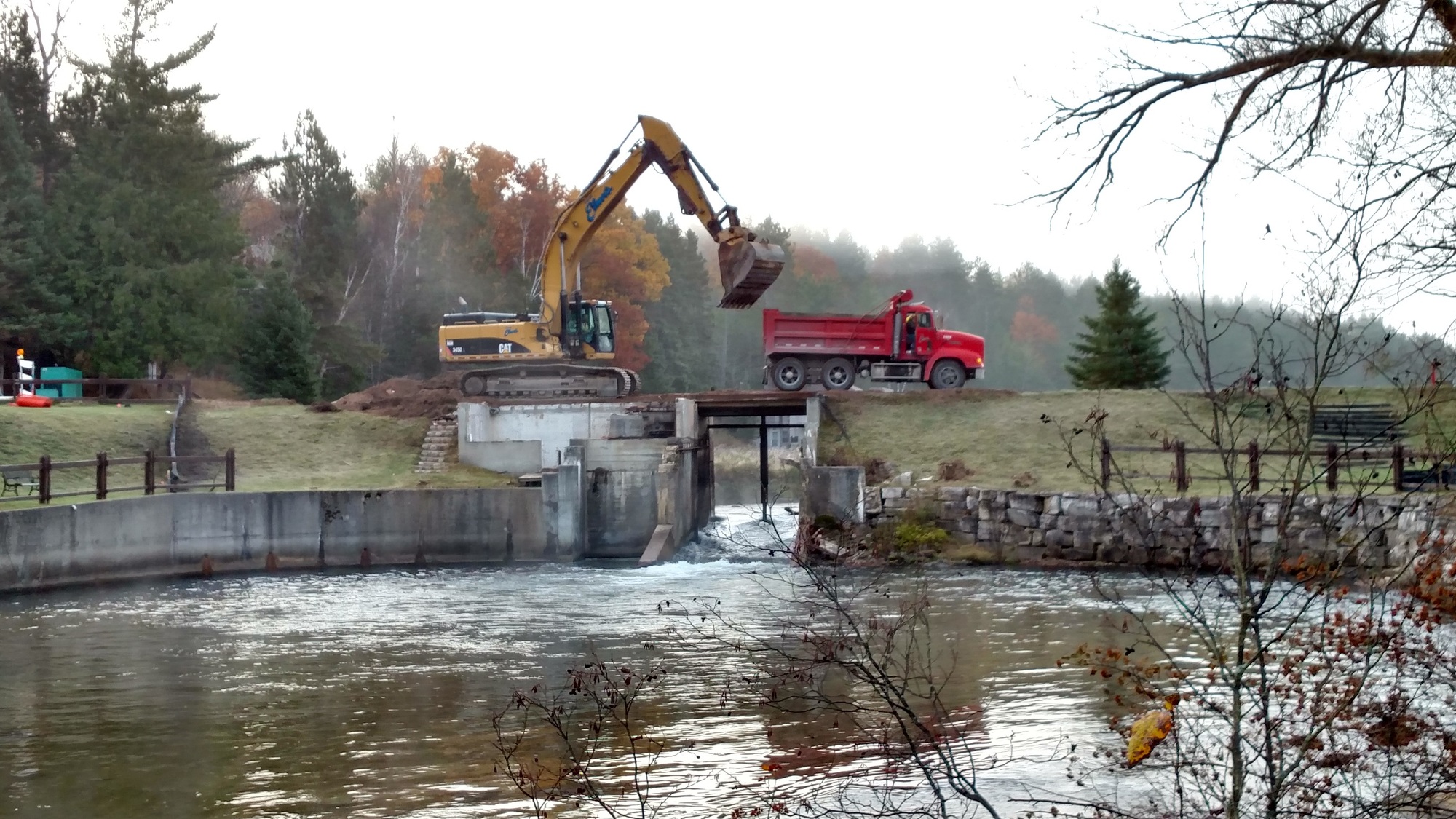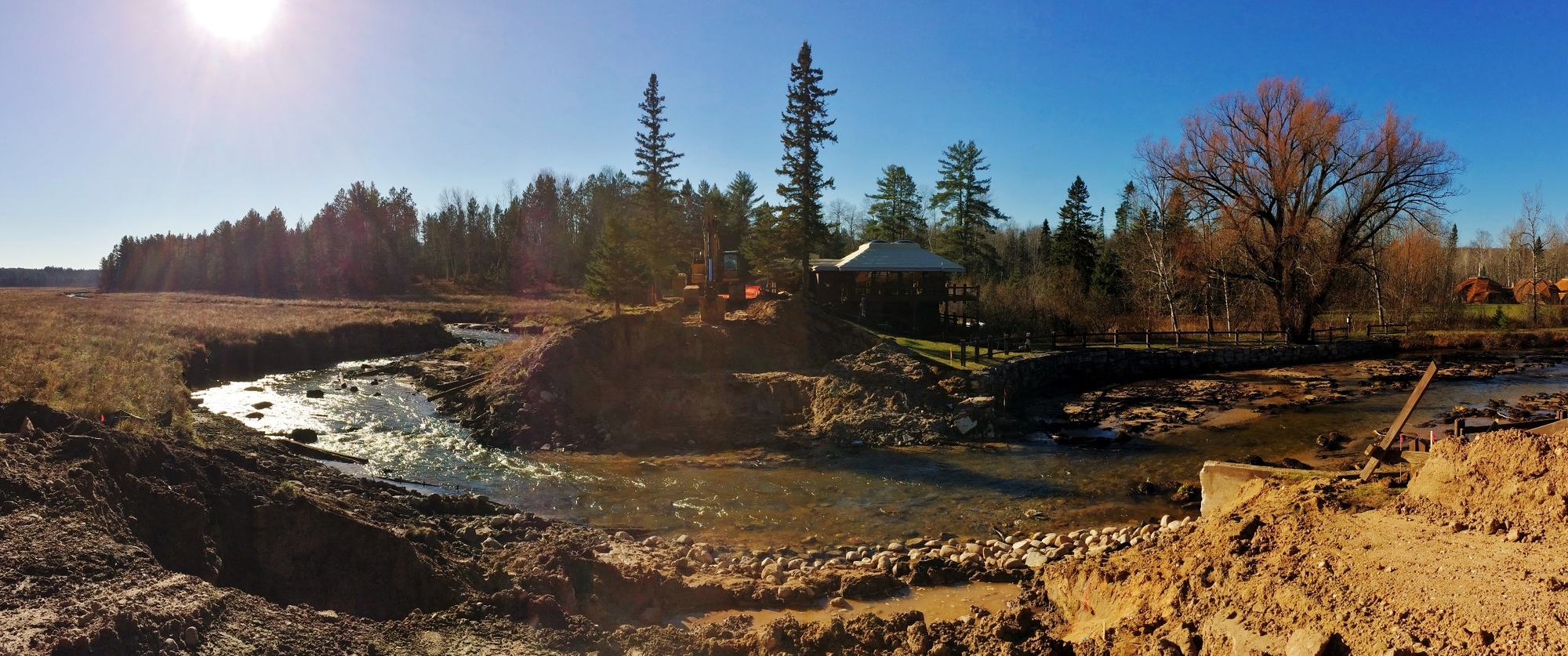Dam removal brings new life to Pigeon River
For nearly a century, the Pigeon River in the northeast Lower Peninsula has been a beautiful, blue-ribbon trout stream scarred with a flaw sometimes fatal to fish – a dam situated about 15 miles downstream from the river’s source.
Now, after a collaborative effort and litigation involving the Michigan Department of Natural Resources, the dam – located near Vanderbilt in Otsego County – has been removed from the landscape, an important accomplishment  that has been a long time coming. that has been a long time coming.
The river was first dammed in the late 1800s by a timber company to help transport logs downstream. Later, the earthen dam was rebuilt by a group of sportsmen known as “The Lansing Club,” with the waters behind the dam maintained as a fishing pond.
In 1957, a heavy rain washed out the dam, killing trout for miles downstream and covering valuable aquatic habitat with silt from the impoundment. Sadly, this would not be the only time the dam would prove disastrous to the river’s trout.
The dam was rebuilt with concrete. Detroit-area entrepreneur J. Oliver Black purchased the property in the 1970s and founded Golden Lotus/Song of the Morning as a yoga retreat. The dam generated electric power for the property.
By 1984, an inspection showed the dam was in need of repair and the DNR issued a permit to allow the water in the impoundment to be drawn down and the necessary repairs made.
Unfortunately, the dam was drained improperly. The repair crew drained the pool too quickly, washing sediment downstream, killing fish and again covering fish spawning habitat.
DNR fisheries biologists estimated 53 percent of trout in the river – located within the first few miles downstream of the dam – were killed, while about 30 percent died farther downstream. In all, the DNR estimated more than 33,000 trout were killed over a 21-mile stretch of the Pigeon River.
The DNR sought redress in court, and a judge ruled that if it happened again he could order the dam removed.
 In 2008, a mechanical failure of the flood gates again caused a massive discharge of sediment. The resulting fish kill was perhaps the biggest yet. Some estimates put mortality at more than 400,000 trout. In 2008, a mechanical failure of the flood gates again caused a massive discharge of sediment. The resulting fish kill was perhaps the biggest yet. Some estimates put mortality at more than 400,000 trout.
But even without the fish kills, the dam was a blemish on an otherwise pristine river – one of the best brook trout fisheries in the state.
“The dam produced quantifiable fish kills, but that doesn’t mean it didn’t kill fish routinely,” said Tim Cwalinski, the DNR fisheries biologist who oversees the Pigeon River. “They operated it as a peaking facility, running peak flows when they were operating the turbines. The river went through multiple ups and downs daily. That’s not good for a river. There’s no stability for the invertebrates, for the (fish) eggs, for everything.”
Removal of the dam will greatly improve the aquatic habitat, allow fish passage upstream and produce better water temperature conditions downstream from the old dam site.
“Not having peaking operations is going to have a positive impact on the downstream invertebrate habitat,” Cwalinski said. “That river has very few issues. The water temperature is good from upstream to downstream – it’s probably 3 to 5 degrees lower now downstream from where that impoundment was. So it provides more trout habitat in summer.”
Removing the dam didn’t come without a fight.
A lawsuit was filed against Golden Lotus/Song of the Morning by the DNR and the Michigan Department of Environmental Quality, joined by Trout Unlimited.
Ultimately, the parties agreed the dam would be dismantled.
“Admittedly, everyone at Song of the Morning dearly loved the lake that for decades served as a reminder of the silent stillness of meditation that is our tradition,” Linda Gabby, board chairwoman of Golden Lotus, Inc., said. “However, when the opportunity arose to heal both the river and our relationships with neighbors, the promise of good will and a restored river outweighed the loss. I haven't looked back.”
Gabby said those who ultimately became partners in the project will recall meeting one memorable evening in spring 2012 at the Pigeon River Forest headquarters to share stories of their personal connections with the river and to explore the possibility of forging agreements that would focus on common purpose.
“To me, this was the turning point in our years of negotiations prior to dam removal,” Gabby said. “The ability to walk away from discord and personal self-interest and to restore good will has been, for me, the great teaching of this experience, this and the discovery that our river has a voice. What a joy it is to hear the sound of the Pigeon as it flows through our retreat center.”
Joe Jarecki, treasurer of Pigeon River Country Association, a group that has long sought the dam’s removal, agreed that during the litigation phase, the parties moved from being adversaries to being partners.
“While the evolution of the Pigeon River is well under way, it’ll be years and possibly decades before the process is complete,” Jarecki said.
One of the biggest hurdles to removing the dam was the cost involved. The DNR came through with an Aquatic Habitat grant and the Great Lakes Fishery Trust kicked in, too. Additional partners also came on board.
 “It took some time for people to come together, but once we had the communities aligned, we were able to get the work done on the ground,” said DNR Deputy Director Bill Moritz, who is chairman of the Great Lakes Fishery Trust Board of Directors. “It’s all about collaboration.” “It took some time for people to come together, but once we had the communities aligned, we were able to get the work done on the ground,” said DNR Deputy Director Bill Moritz, who is chairman of the Great Lakes Fishery Trust Board of Directors. “It’s all about collaboration.”
Brad Jensen is the executive director of Huron Pines, a nonprofit conservation group in the northeast Lower Peninsula that oversaw the Pigeon River dam removal. Jensen praised Michigan’s sportsmen for their support of a license fee increase two years ago.
“Revenue from the license fee increase made this possible,” Jensen said.
Indeed, the aquatic habitat grant that helped fund the dam removal was the first of many the DNR has awarded since the license fee increase, which promised sportsmen “more bang for their buck.”
“This has been a great project,” Jensen said. “So many partners made this come together.”
Bryan Burroughs, executive director of Trout Unlimited in Michigan, said his group was “deeply satisfied” with the outcome.
“It’s what our board set out for,” Burroughs said. “We were very resolute that the dam be removed. It’s been a long ride with a lot of twists, but we’re here.”
But we’re not there. That’ll take time.
“There’s still the sand trap that needs maintenance, but it is working and everything’s progressing very well,” Burroughs said. “We want to make the Pigeon River all that it can be.”
What it can be is 46 miles of free-flowing, blue-ribbon trout stream with a mixture of cobble, gravel and sand that provides ideal trout habitat. provides ideal trout habitat.
The river has established a new channel through the old impoundment. Steep, clay walls, though unnatural, line the banks just upstream of the old dam site. Those walls will eventually break down.
“The river will chew at those walls over time,” Cwalinski said. “We’re only a year into this. The river’s healing and it takes time.
“The real story here was working together and communicating – us, them, Trout Unlimited, Huron Pines, everyone. The true story was breaking down those barriers.”
Find out more information about the Pigeon River.
Catch upcoming stories by subscribing to free, weekly “Showcasing the DNR” articles. Check out previous Showcasing articles.
/Note to editors: Contact: Dave Borgeson, 989-732-3541, ext. 5070, John Pepin, 906-226-1352. Accompanying photos are available below for download and media use. Suggested captions follow. Credit: Michigan Department of Natural Resources.
Crowd: A crowd gathers for a recent ribbon-cutting ceremony on a bridge erected where a dam previously blocked the Pigeon River in Otsego County.
Cutting: From left, Joe Jarecki, treasurer of the Pigeon River Country Association, Linda Gabby, board chairwoman of Golden Lotus Inc., Bryan Burroughs, executive director of Trout Unlimited, Michigan DNR Deputy Director Bill Moritz and Lisha Ramsdell, associate director at Huron Pines, celebrate removal of a dam on the Pigeon River in Otsego County.
Dam: The dam over the Pigeon River recently removed through a cooperative effort and legal action.
Removal: A panoramic view of the dam removal work on the Pigeon River in November 2015.
River: Visitors overlook the Pigeon River cutting its new path after a dam was recently removed from the Song of the Morning property.
Trout: Forty trout over 12 inches and 18 fish over 15 inches, part of the fish kill downstream of the dam on the Pigeon River in June 2008./
The Michigan Department of Natural Resources is committed to the conservation, protection, management, use and enjoyment of the state’s natural and cultural resources for current and future generations. For more information, go to www.michigan.gov/dnr.
|